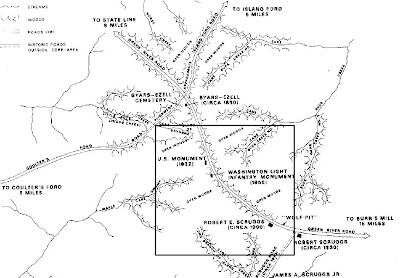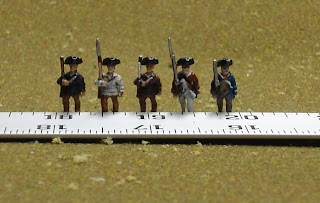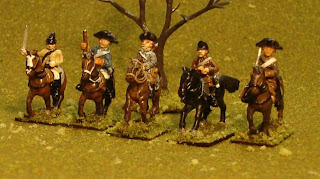[Revised 12/26/09]
General:
An 1822 history, Sketches... of the Highlanders of Scotland, which tells the story of the battle of Cowpens from the perspective of the Scottish soldiers in the 71st Foot, provided one of the clearest descriptions of where the American militia line stood during the battle.
"On the morning of the 17th January 1781, intelligence was received that General Morgan was in front, with his force drawn up on a rising ground, thinly covered with pine trees; the front line being on the crown of the rising ground, and the second 400 paces in rear of the first line."
In other words, there were militia positioned near the number 1 on the map below.
 Not all of the militia were deployed in this one spot. Rather, the militia line was divided into two wings, with one wing located near the crest of Elevation #1 (#6 on the map below), and the other wing located near the Green River Road (#7 on the map below).
Not all of the militia were deployed in this one spot. Rather, the militia line was divided into two wings, with one wing located near the crest of Elevation #1 (#6 on the map below), and the other wing located near the Green River Road (#7 on the map below).
 1 = Continental Light Dragoons, 2 = Mounted Militia, 3 = Right Wing of the Main Line, 4 = Continental Infantry, 5 = Left Wing of the Main Line, 6 = Right Wing of the Militia Line, 7 = Left Wing of the Militia Line, 8 = Skirmishers
1 = Continental Light Dragoons, 2 = Mounted Militia, 3 = Right Wing of the Main Line, 4 = Continental Infantry, 5 = Left Wing of the Main Line, 6 = Right Wing of the Militia Line, 7 = Left Wing of the Militia Line, 8 = Skirmishers
Clear evidence for this deployment can be found in the after action report of the American commander, Brigadier-General Daniel Morgan. Morgan stated:
"An hour before daylight [on the morning of the battle] one of my scouts returned and informed me that Lieut. Col. Tarleton had advanced within five miles of our camp. On this information, I hastened to form as good a disposition as circumstances would admit, and from the alacrity of the troops, we were soon prepared to receive them... The volunteers from North Carolina, South Carolina, and Georgia, under the command of the brave and valuable Col. Pickens, were situated to guard the flanks. Maj. McDowall, of the North Carolina volunteers, was posted on the right flank in front of the line, one hundred and fifty yards; and Maj. Cunningham, of the Georgia volunteers, on the left, at the same distance in front, Colonels Brannon and Thomas, of the South Carolinans, were posted on the right of Maj. McDowall, and Cols. Hay and McCall, of the same corps, on the left of Maj. Cunningham."
Other participant accounts also indicated that the militia were divided into two parts.
Major Joseph McJunkin of South Carolina recalled that, "the regulars [were] in the center, commanded by Col. Howard, the militia on the right and left—the right commanded by Gen. Pickens, the left by _________ [blank in the original]. Col. Washington in the rear with his troop of cavalry."
Sergeant-Major William Seymour of the Delaware Continentals recorded in his journal that, "The militia were... drawn up in front of the standing troops [i.e., the Continentals] on the right and left banks, being advanced about two hundred yards.”
Private Robert Long of South Carolina described the two militia wings to the front of his regiment. Directly in front of him on the right wing was "Major McDowell, of North Carolina... Cols. Thomas and Roebuck [were] in the extreme right. The left wing was similarly formed of militia." See The Statements of Private Robert Long.
Private Adam Files of South Carolina recalled in his pension application that, "The right of the Army was commanded by General Pickens. The left by Colonel McCall and these Center by General Morgan."
Private John Harris of South Carolina claimed in his pension application that, "I was in the left wing for the militia under Col. McCall."
Composition of the Right Wing:
The right wing of the militia line consisted of North and South Carolinians. The North Carolinans were organized into a single battalion under the command of Major Joseph McDowell. Following, in part, the analysis of Lawrence Babits described in A Devil of a Whipping: The Battle of Camden, the South Carolinians were organized into three small battalions. These South Carolinians included the 1st Spartan Regiment, under the command of Colonel John Thomas, and two battalions of the 2nd Spartan Regiment, under the command of Colonel Thomas Brandon, and Lieutenant-Colonel Benjamin Roebuck. According to South Carolinian Aaron Guyton, these battalions were well linked with each other and Colonel Joseph Hayes' Little River regiment:
"I was under Colonel Brandon who had a few Brave men – who stood true for the cause of liberty in the back part of the State who composed our little Army I was out the most of this time sometimes we had 75 sometimes 150 men, and sometimes we had four or five Colonels with from 50 to 150 men. Each of them had command of a Regiment at home & sometimes not more than 5 of his men with him. The colonels were Brandon, Hase, Roebuck, White." Following Babits, these officers were Colonel Thomas Brandon, Colonel Joseph Hayes, Lieutenant-Colonel Benjamin Roebuck, and Major Henry White (second-in-command to John Thomas).
Morgan placed McDowell's battalion to the left side of the South Carolinians. Robert Long's account further adds that Thomas and Roebuck were on the extreme right. By extension, Brandon's battalion must have been deployed next to McDowell's men.
Composition of the Left Wing:
The left wing of the militia line consisted of Georgians and South Carolinians.
Major John Cunningham commanded a small battalion of Georgia militia. According to Major James Jackson of Georgia, Cunningham's command was comprised of three companies under the commands of Captains Samuel Hammond, Joshua Inman, and George Walton. Babits named a Captain Richard Heard in place of Hammond. One David Thurmond claimed, in his pension application, to have been a captain in this battalion at the battle.
Major (soon to be Colonel) James McCall commanded a regiment of South Carolina State Troops. McCall's regiment was recruited from Georgia and South Carolina "refugees." This regiment was supposed to be equipped as dragoons, but the regiment was still being organized at the time of the battle, and only a relatively small number were prepared to fight in that capacity. McCall took personal command of those troops equipped as dragoons and fought alongside Lieutenant-Colonel William Washington and the remainder of the American cavalry during the battle. The rest of the troops served under McCall's second-in-command, Captain (soon to be Major) Samuel Hammond. (Hammond's pension application is the source of many of these details).
Morgan's account indicates that the Georgians served on the right end of the left wing, while South Carolinians served on the left. Morgan placed Colonel Joseph Hayes' regiment of South Carolinians on the left wing, but Long convincingly placed it on the main line.
There are some other bodies of troops that were likely a part of the left wing that are generally not described in accounts of the battle. These may have included Captain John Irby's company of Georgia refugees (see Little River Regiment), and other, miscellaneous volunteers (see pension application of George Harbinson).
More significantly, Colonel Andrew Pickens' Upper Ninety-Six District Regiment of South Carolina militia was likely on the left wing. The few references to Pickens' regiment in accounts of the battle may reflect the absence of the regiment's senior leadership. Pickens was given overall command of the front-line militia and so was away from his regiment. Major Alexander Noble possibly had command of the American baggage (at least this was his assignment after the battle). Private Patrick Norris mentioned that Noble was "officer of the guard" and after the battle "conducted the forge wagon with a considerable number of arms, that were taken from Tarleton at his defeat to Gilbertstown in North Carolina."
McCall was well known to the men of Pickens' regiment having come from the same part of the state and having been, at one time, a captain in the regiment. It can be difficult to distinguish in some pension applications whether the applicant was a South Carolina refugee attached to McCall or whether the individual was in Pickens' regiment.
John Harris is one individual whose account is somewhat ambiguous.
Early in the war he was clearly in what would become Pickens' regiment: "In the summer of 1778–I was again called out and went in Captain Noble’s Company under Col. Andrew Williamson and Maj. Andrew Pickens." This was before Noble and Pickens had been promoted.
Sometime in 1780, however, he "joined Col. (then Capt McCall) in an enterprise which he under took to surprize the British at Augusta... [later] McCall retreated up the Saluda River spent two weeks in the mountains on the border of North Carolina, almost without food, and joined Gen’l. Morgans army in North Carolina a short time after the Battle of Kings Mountain. With this army I remained until the battle of the Cowpens Jan’y. 1781, in which I was in the left wing for the militia under Col. McCall."
A number of pension applications, however, clearly establish Pickens' regiment as one present at the battle.
Charles Holland was a private in Joseph Pickens' company of Colonel Andrew Pickens' regiment:
"he volunteered, some time in the month of September (as well as he can recollect) 1776, in a company of militia under the command of Captain James McCall, in the District then called Ninety-Six, now Abbeville, in the State of South Carolina, that said company was attached to a Regiment, or corps of men, under the command of Major Andrew Williamson or Winson, the Colonel, if any, not recollected; that he continued with Captain McCall until about a month July 1777, when the Captain was taken prisoner by the Indians & this relator was transferred to a militia company commanded by Captain Andrew Pickens, in the same Regiment; that soon after this, Williamson was promoted to the command of the Regiment & Captain Pickens was made the Major... [later,] one Joseph Pickens was promoted to the captaincy of said Company... and Major Andrew Pickens became the Commandant of this Regiment; and one Alexander Noble became Major."
Holland was also at the battle of Cowpens, where a British cavalryman wounded him "by a sword thrust through the body, which disabled him for active service for two or three months." Others in his regiment experienced the same fate.
James Pettigrew was a private in James Caldwell's company:
"The next battle he was in of any note was at the Cowpens under General Morgan. General Pickens, Col. Anderson, Colonel McCall, Major Noble, Lieut. Carlile [Francis Carlisle] were in that engagement and most of them, if not all, were under the command of General Pickens and from Abbeville District. He recollects that Colonel Washington with his cavalry was there and saved the militia from inevitable destruction. James Caldwell commanded this applicant's company and was cut almost to death by Tarlton's horsemen so much so that he had to be borne from the field."
Jeremiah Files was a private in John Files' company:
Jeremiah "enrolled himself as a volunteer under Colonel Andrew Pickens and at the time of his enrollment resided in Abbeville District in the State of South Carolina and marched from thence as a volunteer with Col.Pickens to Granvile Shoals on Packlet River and there joined General Morgan about the first of January in the year 1781 and then placed under the command of Captain McKall [James McCall] in the Battalion of Major Noble in the Regiment of Colonel Andrew Pickens of the South Carolina Militia... we marched under General Morgan to the Cowpens and was at the Battle fought there against Tarltons Legion on the Wednesday Morning on the 17th day of January 1781... This Deponent was wounded by Tarleton's Dragoons on the head – on the left arm and on the right hand each wound was made with a sword & the wounds are now visible the wounds Greatly Disabled this Deponent -- & Stunned him for some time & one Captain Alexander of Rowan County North Carolina was the first man to come to his relief & informed him of our victory."
Samuel Hammond's dubious sketch of the battle shows Pickens' regiment on the left wing of the main line (see The Hammond Map). However, Pettigrew's statement (see above) links McCall with Pickens' regiment, suggesting that their regiments served together during the battle.
Sources:
David Stewart's 1825 Sketches... of the Highlanders of Scotland is available through Google Books.
Morgan's report of the battle can be found in James Graham's 1856 The Life of General Daniel Morgan.
For a transcription of Long's accounts of the battle see The Statements of Private Robert Long.
John Moncure's The Cowpens Staff Ride and Battlefield Tour webpage has a transcription of the statements by Hammond, Seymour, and Howard.
This issue of the online magazine, Southern Campaigns of the American Revolution has complete transcriptions and commentary on McJunkin's statements.
A transcription of William Seymour's journal can also be found on this Battle of Camden website.
Will Graves transcribed the pension application of David Thurmond (.pdf file).
Will Graves transcribed the pension application of Adam Files, which can be read here (.pdf file).
C. Leon Harris transcribed the pension application of John Harris, which can be read here (.pdf file).
Lawrence Babits' A Devil of a Whipping: The Battle of Cowpens is available through amazon.com.
Will Graves transcribed the pension application of Aaron Guyton (.pdf file).
Will Graves transcribed the pension application of Samuel Hammond (.pdf file).
C. Leon Harris transcribed the pension application of George Harbinson (.pdf file).
Will Graves transcribed the pension application of Patrick Norris (.pdf file).
Will Graves transcribed the pension application of Charles Holland (.pdf file).
Nan Overton West transcribed the pension application of James Pettigew (.pdf file).
Will Graves transcribed the pension application of Jeremiah Files (.pdf file).
 The American Deployment at Cowpens. "Rivulets" exist on the flanks of the American army, but not in front. 1 = Continental Light Dragoons, 2 = Mounted Militia, 3 = Right Wing of the Main Line, 4 = Continental Infantry, 5 = Left Wing of the Main Line, 6 = Right Wing of the Militia Line, 7 = Left Wing of the Militia Line, 8 = Skirmishers.
The American Deployment at Cowpens. "Rivulets" exist on the flanks of the American army, but not in front. 1 = Continental Light Dragoons, 2 = Mounted Militia, 3 = Right Wing of the Main Line, 4 = Continental Infantry, 5 = Left Wing of the Main Line, 6 = Right Wing of the Militia Line, 7 = Left Wing of the Militia Line, 8 = Skirmishers. Possible Location of Alexander's Chesney's Rivulet. The medium blue line in the bottom half of the map shows the approximate path of Chesney's rivulet, as based on Babits' maps and erosion patterns visible in the topography. (Contour lines are at 20-foot intervals; a more detailed topographic map may suggest a different path).
Possible Location of Alexander's Chesney's Rivulet. The medium blue line in the bottom half of the map shows the approximate path of Chesney's rivulet, as based on Babits' maps and erosion patterns visible in the topography. (Contour lines are at 20-foot intervals; a more detailed topographic map may suggest a different path).




 If the same 100 man battalion were to be deployed as a single rank in open order, then the interval between files would be about 24 inches. Again, assuming that a typical soldier was something like 18 inches across the shoulders, each soldier would occupy 42 inches of space. The battalion, in turn, would have a frontage of 4,200 inches, or 350 feet. At 1:20 scale with 15mm miniatures this translates into 5 miniatures with a frontage of 2.00 inches. The picture below provides a visual demonstration.
If the same 100 man battalion were to be deployed as a single rank in open order, then the interval between files would be about 24 inches. Again, assuming that a typical soldier was something like 18 inches across the shoulders, each soldier would occupy 42 inches of space. The battalion, in turn, would have a frontage of 4,200 inches, or 350 feet. At 1:20 scale with 15mm miniatures this translates into 5 miniatures with a frontage of 2.00 inches. The picture below provides a visual demonstration.

